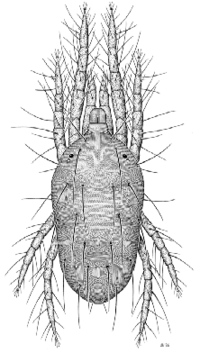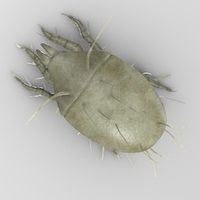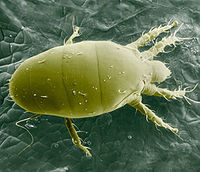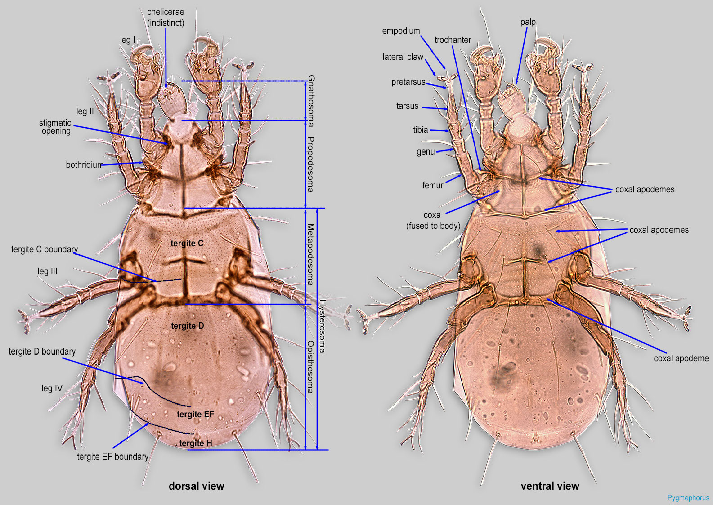Prostigmata: Difference between revisions
No edit summary |
m The LinkTitles extension automatically added links to existing pages (https://github.com/bovender/LinkTitles). |
||
| (17 intermediate revisions by 2 users not shown) | |||
| Line 1: | Line 1: | ||
== | == Definition == | ||
The Prostigmata (also known as "sucking [[mites]]") is a suborder of the Trombidiformes, found in the class Arachnida. These mites are one of the oldest suborders found on earth, together with the [[Oribatida]], dating back to the Devonian Era. The prostigmatic mites contains a very diversified diet within its [[organisms]], many are predators, but there are also families of fungal eating, plant eating, microbial eating and parasites. These mites can vary in size, from 0.1 reaching up to 10 millimeters. <!--Great content just sounds a little informal--> | |||
== Classification == | |||
'''Domain''': Eukarya | |||
'''Kingdom''': Animalia | |||
'''Phylum''': [[Arthropoda]] | |||
'''Subphylum''': Chelicerata | |||
'''Class''': Arachnida | |||
'''Subclass''': [[Acari]] | |||
'''Order''': Trombidiformes | |||
'''Suborder''': Prostigmata | |||
== Examples of organisms and their diet: == | == Examples of organisms and their diet: == | ||
1) Spider mites (''Tetrachynus urticae''), which eat plants, are known for being a pest. | 1) Spider mites (''Tetrachynus urticae''), which eat plants, are known for being a pest. | ||
[[File:440px-ACAR Tetranychidae Tetranychus urticae.png|200px|thumb|right|Picture of a spider mite]] | |||
2) ''Demodex'' mites are parasites to vertebrates, while invertebrates include ''Acarapis woodi'' that | 2) ''Demodex'' mites are parasites to vertebrates, while [[invertebrates]] include ''Acarapis woodi'' that prey on honeybees. | ||
[[File:Demodex.jpeg|200px|thumb|right|Picture of a Demodex mite]][[File:Acarapis-woodi-tracheal-mite-of-honey-bees.jpeg|200px|thumb|right|Picture of a Acarapis woodi]] | |||
3) Prostigmatic mites from the family ''Eupodidae'' are opportunistic organisms to fungi. | 3) Prostigmatic mites from the family ''Eupodidae'' are opportunistic organisms to fungi. | ||
4) The families ''Eupodidae'',''Tarsonemidae'', and ''Nanorchestidae'' feed on algae. | 4) The families ''Eupodidae'',''Tarsonemidae'', and ''Nanorchestidae'' feed on [[algae]]. | ||
<!--I like the direction but is rather scarce. A lot of options to talk about like biology, ecology, current status, unique aspects--> | [[File:Polyphagotarsonemus latus, USDA BARC.jpeg|200px|thumb|right|Picture of an Eupodidae mite]] | ||
<!--I like the direction but is rather scarce. A lot of options to talk about like biology, [[ecology]], current status, unique aspects--> | |||
== Characteristics == | == Characteristics == | ||
| Line 37: | Line 63: | ||
<!--does not tell me much, more details and substance could improve this section--> | <!--does not tell me much, more details and substance could improve this section--> | ||
[[File:FIG-7 Hetero-3-BMOC 97-0808-002 Pygmephorus 40x]] | [[File:FIG-7 Hetero-3-BMOC 97-0808-002 Pygmephorus 40x.png]] | ||
Detailed descriptions of each term can be found in their glossary page [6] | Detailed descriptions of each term can be found in their glossary page [6] | ||
| Line 43: | Line 69: | ||
== Prostigmata Life Cycle == | == Prostigmata Life Cycle == | ||
Life cycle’s of arthropods are very similar between different organisms of different classes. While they have the same standard stages, the duration differs between species, with a total average of 3 weeks. Mites go through 5 stages before death: egg, larvae, protonymph, deuteronymph, adult. | Life cycle’s of [[arthropods]] are very similar between different organisms of different classes. While they have the same standard stages, the duration differs between species, with a total average of 3 weeks. Mites go through 5 stages before death: egg, larvae, protonymph, deuteronymph, adult. | ||
1) Eggs: The eggs are laid on the host or on the soil by the female, the amount varies between species | 1) Eggs: The eggs are laid on the host or on the [[soil]] by the female, the amount varies between species | ||
2) Larva: The eggs hatch and larva emerge from them, | 2) Larva: The eggs hatch and larva emerge from them, which feeds on skin cells. In some species, this is the only parasitic stage, which can last 3 to 4 days | ||
3) Nymph: The larvae goes through dormancy for 24 hours, and develop into a nymph, which has 2 stages. The whole stage has a 3 to 4 day period | 3) Nymph: The larvae goes through dormancy for 24 hours, and develop into a nymph, which has 2 stages. The whole stage has a 3 to 4 day period | ||
4)Adult: After the nymphs develop into an adult, they can live either on the surface or by making burrows | 4)Adult: After the nymphs develop into an adult, they can live either on the surface or by making burrows | ||
[[File:Mite lifecycle-01.png]] | |||
<!--Really like this section, if theres more info out there it would really benefit this section--> | <!--Really like this section, if theres more info out there it would really benefit this section--> | ||
<!--A really good start here. seems rather light, adding more details would really improve this article--> | <!--A really good start here. seems rather light, adding more details would really improve this article--> | ||
== References == | == References == | ||
[1]Coleman, D. C., M. C. Callaham, and D. A. Crossley. 2018. FUNDAMENTALS OF SOIL ECOLOGY. 3Rd edition. Candice JancoCambridge, MA. | [1]Coleman, D. C., M. C. Callaham, and D. A. Crossley. 2018. FUNDAMENTALS OF [[Soil Ecology|SOIL ECOLOGY]]. 3Rd edition. Candice JancoCambridge, MA. | ||
[2]Contributors, W. 2012, July 18. Mite Life Cycle. https://en.wikivet.net/Mite_Life_Cycle. | [2]Contributors, W. 2012, July 18. Mite Life Cycle. https://en.wikivet.net/Mite_Life_Cycle. | ||
Latest revision as of 14:45, 1 May 2025
Definition
The Prostigmata (also known as "sucking mites") is a suborder of the Trombidiformes, found in the class Arachnida. These mites are one of the oldest suborders found on earth, together with the Oribatida, dating back to the Devonian Era. The prostigmatic mites contains a very diversified diet within its organisms, many are predators, but there are also families of fungal eating, plant eating, microbial eating and parasites. These mites can vary in size, from 0.1 reaching up to 10 millimeters.
Classification
Domain: Eukarya
Kingdom: Animalia
Phylum: Arthropoda
Subphylum: Chelicerata
Class: Arachnida
Subclass: Acari
Order: Trombidiformes
Suborder: Prostigmata
Examples of organisms and their diet:
1) Spider mites (Tetrachynus urticae), which eat plants, are known for being a pest.

2) Demodex mites are parasites to vertebrates, while invertebrates include Acarapis woodi that prey on honeybees.


3) Prostigmatic mites from the family Eupodidae are opportunistic organisms to fungi.
4) The families Eupodidae,Tarsonemidae, and Nanorchestidae feed on algae.

Characteristics
According to a study in the University of Michigan [5], these are the morphological features of the Prostigmata body:
1) Absence of the Tritosternum (Biflagellate structure in the ventral side of the body)
2) The leg joint is fused with their body
3) The stigmatic openings (used for feeding), are present but either near the chelicerae or on the dorsal side of the propodosoma
4) The empodial and lateral claws are usually present in some legs
5) The male Aedeagus (reproductive structure) can be both present or absent
6) The dispersal stage is not substantially different from the non-dispersal stage
7) The attachment organ is absent
8) The chelicerae is developed but sometimes indistinct
Detailed descriptions of each term can be found in their glossary page [6]
Prostigmata Life Cycle
Life cycle’s of arthropods are very similar between different organisms of different classes. While they have the same standard stages, the duration differs between species, with a total average of 3 weeks. Mites go through 5 stages before death: egg, larvae, protonymph, deuteronymph, adult.
1) Eggs: The eggs are laid on the host or on the soil by the female, the amount varies between species
2) Larva: The eggs hatch and larva emerge from them, which feeds on skin cells. In some species, this is the only parasitic stage, which can last 3 to 4 days
3) Nymph: The larvae goes through dormancy for 24 hours, and develop into a nymph, which has 2 stages. The whole stage has a 3 to 4 day period
4)Adult: After the nymphs develop into an adult, they can live either on the surface or by making burrows

References
[1]Coleman, D. C., M. C. Callaham, and D. A. Crossley. 2018. FUNDAMENTALS OF SOIL ECOLOGY. 3Rd edition. Candice JancoCambridge, MA.
[2]Contributors, W. 2012, July 18. Mite Life Cycle. https://en.wikivet.net/Mite_Life_Cycle.
[3]Contributors, W. 2021, April. Mite. Wikimedia Foundation. https://en.wikipedia.org/wiki/Mite#Reproduction_and_life_cycle.
[4]Contributors, W. 2021, March 15. Prostigmata. Wikimedia Foundation. https://en.wikipedia.org/wiki/Prostigmata.
[5]Klimov, P., B. OConnor, R. Ochoa, G. Bauchan, A. Redford, and J. Scher. 2016, October. Bee Mite ID. http://idtools.org/id/mites/beemites/bmites_morphology.php.
[6]Klimov, P., B. OConnor, R. Ochoa, G. Bauchan, A. Redford, and J. Scher. 2016, October. Bee Mite ID. http://idtools.org/id/mites/beemites/glossary.php#a.
[7]Murray, A. (n.d.). All about prostigmatid mites. https://www.chaosofdelight.org/all-about-mites-prostigmata.
[8]Proctor, H. 1998, August 12. Page: Tree of Life Trombidiformes. Trombidiform mites. http://tolweb.org/Trombidiformes/2568.
